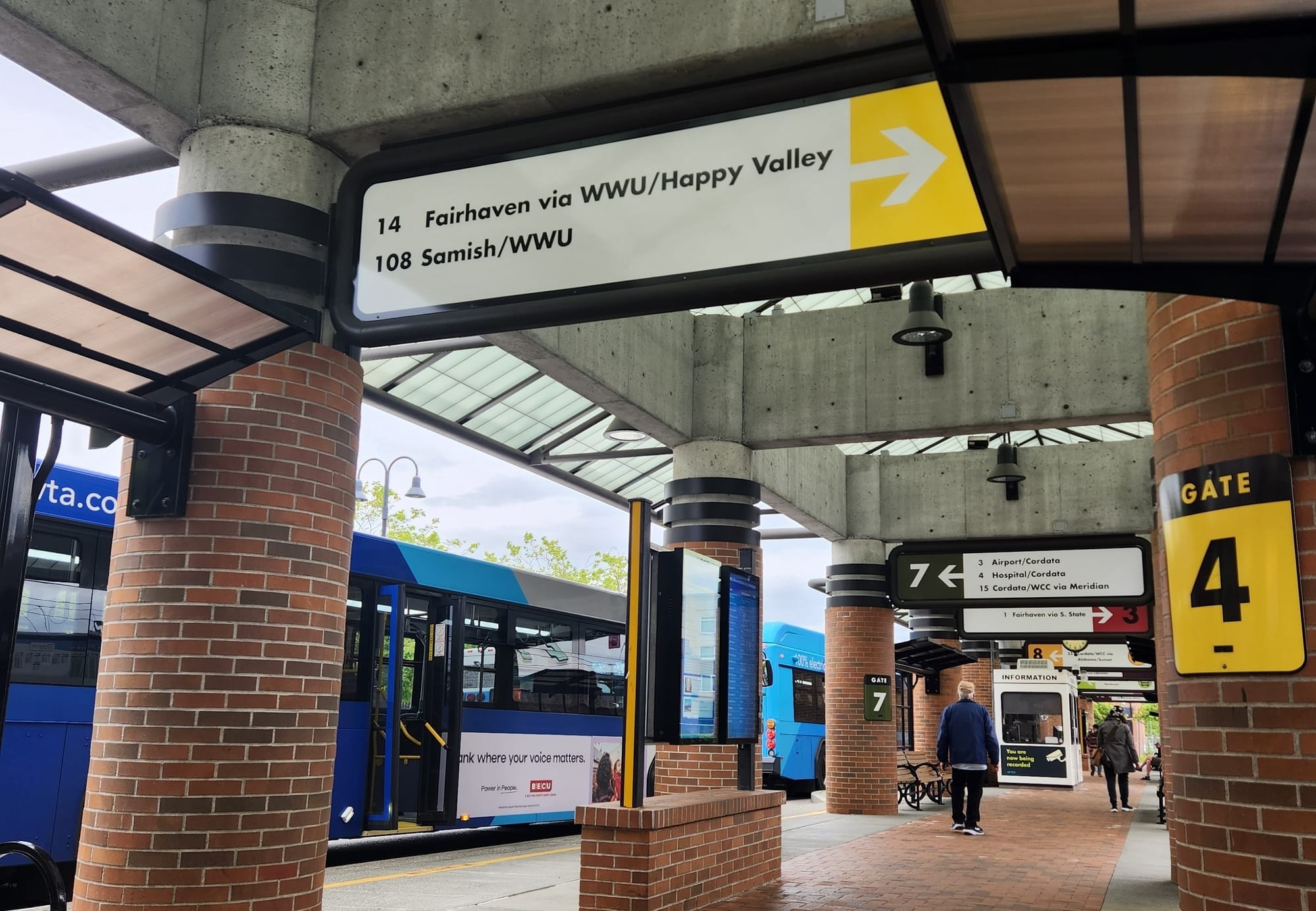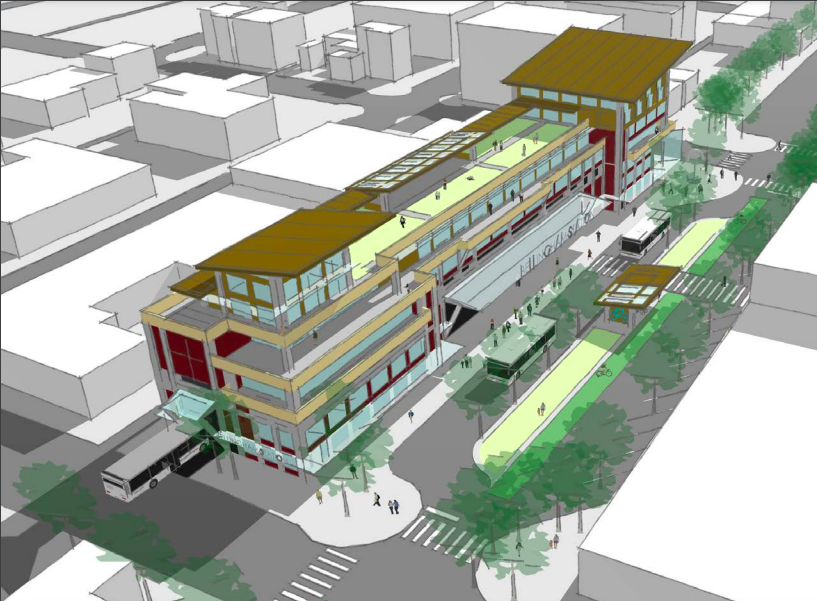News & Notes: Gate Changes at Bellingham Station; Route 525 Back to Normal; and Hydrogen Buses
The gate change for Route 108 highlights the challenge of limited space for buses serving the downtown transit center.

In this edition:
- Limited space for WTA buses at Bellingham Station prompts gate change for Route 108.
- Route 525 returned to its normal route following partial reopening of Electric Avenue bridge.
- King County Metro looks to add buses powered by hydrogen fuel cells to its fleet; RapidRide G opens September 14 in Seattle.
Downtown Bellingham
Limited Space for Buses at Bellingham Station Prompts Route 108 Gate Change
Whatcom Transit Authority personnel orchestrate scheduling magic at Bellingham Station, the downtown transit center that can accommodate 22 separate bus routes at its 10 bus bays arranged along a covered passenger concourse. The agency can't squeeze much more bus service through Bellingham Station during peak times on weekdays due to limited room for buses. It's one of the reasons WTA officials have been exploring options for replacing the existing transit center.
One of the things BhamByBus appreciates at Bellingham Station in its current configuration is the clearly noted route and destination information by gate, each one designated by number. Additionally, WTA routes that serve the same GO Line corridor are grouped at the same gate, e.g., the 500-series buses that constitute the Plum GO Line, Routes 512, 525, 533 and 540, all leave from Gate 2.
Which brings us to Route 108 (Samish/WWU), one of the looping routes that serves Western Washington University, not to be confused with its counterclockwise sibling Route 107 (WWU/Samish), which runs in the opposite direction on the loop around Sehome Hill Arboretum via Ellis Street, Samish Way, and the Blue GO Line corridor on Bill McDonald Parkway, High Street, and Billy Frank Jr. Street.
On Wednesday, the WTA announced that buses serving Route 108, which operates weekdays and Saturdays, will depart out of different gates depending on the day:
- Weekdays, Route 108 operates out of Gate 4.
- Saturdays, Route 108 operates out of Gate 6.
In a Facebook comment responding to a question about what prompted the change, the agency said the move was necessary due to limited room for bus layovers at Bellingham Station. "Due to scheduling, we don't have the space or time to keep the 108 at one gate for boarding, so we're using two gates."
Fortunately, Gates 4 and 6 are adjacent, which should help limit the potential confusion of where Route 108 will depart from since both gates now list Route 108. Friday morning, a stand-up sign was in place on the concourse to reiterate the weekday gate change information.

Agency stakeholders have been assessing options for expanding Bellingham Station's capacity. According to WTA's May 2023 Bellingham Station Visioning Study:
WTA's long range transit plan, WTA 2040, identifies service expansion that will allow transit services to grow alongside population growth and help make transit a more viable option. However, bus bay capacity at Bellingham Station is currently limited. Additionally, WTA is preparing to accommodate electric and potentially articulated buses for high-ridership routes. While there is capacity to add weekend service at the station, additional capacity is required to increase weekday service during peak hours, which is the primary need.
In addition to accommodating expanded transit service through the downtown transit center, agency stakeholders have been considering transit-oriented development options to accommodate housing above the station.
Whatcom Falls Park
WTA's Route 525 Has Returned to Normal Route via Electric Avenue; Bridge Has Partially Reopened With 1 Lane of Traffic
Following the City of Bellingham partially reopening the Electric Avenue bridge over Whatcom Creek on Tuesday to some vehicular traffic earlier this week, buses serving the Whatcom Transit Authority's Route 525 (Downtown to Barkley via Lakeway), which had been on detour since June 3, returned to their normal route.
Rotten timbers discovered during an inspection prompted an emergency closure of the bridge near Whatcom Falls Park and Bloedel Donovan Park, which reopened with one lane of traffic controlled by a traffic signal.
Seattle
King County Metro Looks to Test 4 Hydrogen-Powered Buses; Rapid Ride G Nears Completion on Madison Street
In the Seattle area, the state's largest transit agency, King County Metro, is looking to acquire four buses powered by hydrogen fuel cells in 2026 to test their performance, Mass Transit Magazine reports, something that could lead to wider adoption as transit agencies look toward zero-emissions bus fleets:
King County Metro was the first public transit agency in North America to adopt diesel-hybrid buses in 2004. In 2020, the agency retired its last diesel-only buses. Forty battery-electric buses (BEB) from New Flyer of America started entering service in 2022, with another 89 scheduled to begin arriving in 2026 from GILLIG.
While BEBs have an expected range of 140 miles for a 60-foot bus and 220 miles for a 40-foot bus, King County Metro and other transit agencies have experienced range limitations and variability, especially in cold weather. The agency says hydrogen fuel cell buses have the potential to travel up to 300 miles and their extended range has particular promise on all-day, frequent routes.
If King County Metro finds buses powered by hydrogen fuel cells to be successful, don't be surprised if other transit agencies in Washington follow the agency's lead, given state interest in jumpstarting the green hydrogen economy, plus $1 billion in federal Regional Clean Hydrogen Hubs grant funding for projects in the Pacific Northwest.
“Green hydrogen is a critical tool in Washington’s decarbonization toolkit and we must use it wisely,” Washington Gov. Jay Inslee said in a February statement. “Since we need significant amounts of clean electricity to produce hydrogen, we know we must target the most critical sectors that are harder to decarbonize, such as industrial uses and heavy transportation.”
- Also in Seattle, Rapid Ride G along Madison Street, is nearing completion, The Urbanist reports. The Seattle Department of Transportation announced that the forthcoming new bus rapid transit line connecting Colman Dock, First Hill, Capitol Hill, and Madison Valley will open September 14. Unlike King County Metro's other RapidRide lines, the G Line will have dedicated center-running bus-only lanes for much of its length and special articulated buses that also have left-facing doors, allowing access at stops positioned on traffic islands in the middle of the street.
- Have local and regional transit and transportation news to share? Email BhamByBus.
- Follow BhamByBus on Instagram.
